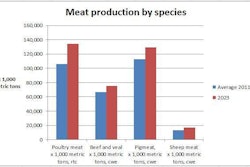The net energy system was first introduced as the ideal system to use when formulating diets for ruminants, especially dairy cattle. But, mostly due to work done in France, and also to a lesser extent in the United States and some other countries, the net energy concept has caught up with pigs. Although the metabolizable energy system has served the poultry industry faithfully up to now, there are efforts to be replaced by the more accurate, modern and precise system of net energy.
Net energy values
In a recent study, thirty pelleted diets were given to broiler chickens (eight birds per diet; 21 to 35 days of age) for individual in vivo measurements of dietary net energy (NE) value using three trials with 10 diets/trial. NE was measured according to the body analysis method. The basal metabolism component of NE values was calculated on the basis of mean metabolic weight using a coefficient obtained in a previous experiment. Information about apparent metabolizable energy (AME) value of diets, AME corrected to zero nitrogen retention (AMEn), and digestibility values for dietary proteins, lipids, starch and sugars were available also from a previous publication.
In each trial, mean NE/AME ratios of diets varied by about 6 percent. From the multiple regression equations (n=30) expressing NE and AMEn values as a function of digestible dietary component, it was deduced that the NE/AMEn ratios assigned to dietary components were 0.760, 0.862, 0.806, 0.690 and 0.602 for proteins, lipids, starch, (sucrose+glucose), and fermentable sugars (α-galacto-oligosaccharides and lactose), respectively. Regression calculations showed that the NE values assigned to individual birds (n=240) could also be predicted with diet AMEn values (NE=0.80 AMEn; R-squared=0.770).
This study is a step towards producing a net energy system for poultry, especially broilers. It is to be expected, as is the case in pigs, that for older birds (layers and breeders) slightly different net energy values will be required, but this is a step towards the end of the refinement process. For now, we need a basic set of net energy values for basic ingredients to start experiment with practical formulations on a commercial level.














